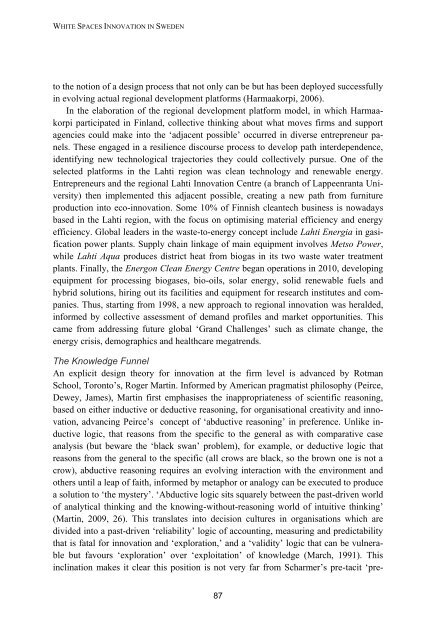White Spaces Innovation in Sweden - Innovation policy for ... - Vinnova
White Spaces Innovation in Sweden - Innovation policy for ... - Vinnova
White Spaces Innovation in Sweden - Innovation policy for ... - Vinnova
Create successful ePaper yourself
Turn your PDF publications into a flip-book with our unique Google optimized e-Paper software.
WHITE SPACES INNOVATION IN SWEDENto the notion of a design process that not only can be but has been deployed successfully<strong>in</strong> evolv<strong>in</strong>g actual regional development plat<strong>for</strong>ms (Harmaakorpi, 2006).In the elaboration of the regional development plat<strong>for</strong>m model, <strong>in</strong> which Harmaakorpiparticipated <strong>in</strong> F<strong>in</strong>land, collective th<strong>in</strong>k<strong>in</strong>g about what moves firms and supportagencies could make <strong>in</strong>to the „adjacent possible‟ occurred <strong>in</strong> diverse entrepreneur panels.These engaged <strong>in</strong> a resilience discourse process to develop path <strong>in</strong>terdependence,identify<strong>in</strong>g new technological trajectories they could collectively pursue. One of theselected plat<strong>for</strong>ms <strong>in</strong> the Lahti region was clean technology and renewable energy.Entrepreneurs and the regional Lahti <strong>Innovation</strong> Centre (a branch of Lappeenranta University)then implemented this adjacent possible, creat<strong>in</strong>g a new path from furnitureproduction <strong>in</strong>to eco-<strong>in</strong>novation. Some 10% of F<strong>in</strong>nish cleantech bus<strong>in</strong>ess is nowadaysbased <strong>in</strong> the Lahti region, with the focus on optimis<strong>in</strong>g material efficiency and energyefficiency. Global leaders <strong>in</strong> the waste-to-energy concept <strong>in</strong>clude Lahti Energia <strong>in</strong> gasificationpower plants. Supply cha<strong>in</strong> l<strong>in</strong>kage of ma<strong>in</strong> equipment <strong>in</strong>volves Metso Power,while Lahti Aqua produces district heat from biogas <strong>in</strong> its two waste water treatmentplants. F<strong>in</strong>ally, the Energon Clean Energy Centre began operations <strong>in</strong> 2010, develop<strong>in</strong>gequipment <strong>for</strong> process<strong>in</strong>g biogases, bio-oils, solar energy, solid renewable fuels andhybrid solutions, hir<strong>in</strong>g out its facilities and equipment <strong>for</strong> research <strong>in</strong>stitutes and companies.Thus, start<strong>in</strong>g from 1998, a new approach to regional <strong>in</strong>novation was heralded,<strong>in</strong><strong>for</strong>med by collective assessment of demand profiles and market opportunities. Thiscame from address<strong>in</strong>g future global „Grand Challenges‟ such as climate change, theenergy crisis, demographics and healthcare megatrends.The Knowledge FunnelAn explicit design theory <strong>for</strong> <strong>in</strong>novation at the firm level is advanced by RotmanSchool, Toronto‟s, Roger Mart<strong>in</strong>. In<strong>for</strong>med by American pragmatist philosophy (Peirce,Dewey, James), Mart<strong>in</strong> first emphasises the <strong>in</strong>appropriateness of scientific reason<strong>in</strong>g,based on either <strong>in</strong>ductive or deductive reason<strong>in</strong>g, <strong>for</strong> organisational creativity and <strong>in</strong>novation,advanc<strong>in</strong>g Peirce‟s concept of „abductive reason<strong>in</strong>g‟ <strong>in</strong> preference. Unlike <strong>in</strong>ductivelogic, that reasons from the specific to the general as with comparative caseanalysis (but beware the „black swan‟ problem), <strong>for</strong> example, or deductive logic thatreasons from the general to the specific (all crows are black, so the brown one is not acrow), abductive reason<strong>in</strong>g requires an evolv<strong>in</strong>g <strong>in</strong>teraction with the environment andothers until a leap of faith, <strong>in</strong><strong>for</strong>med by metaphor or analogy can be executed to producea solution to „the mystery‟. „Abductive logic sits squarely between the past-driven worldof analytical th<strong>in</strong>k<strong>in</strong>g and the know<strong>in</strong>g-without-reason<strong>in</strong>g world of <strong>in</strong>tuitive th<strong>in</strong>k<strong>in</strong>g‟(Mart<strong>in</strong>, 2009, 26). This translates <strong>in</strong>to decision cultures <strong>in</strong> organisations which aredivided <strong>in</strong>to a past-driven „reliability‟ logic of account<strong>in</strong>g, measur<strong>in</strong>g and predictabilitythat is fatal <strong>for</strong> <strong>in</strong>novation and „exploration,‟ and a „validity‟ logic that can be vulnerablebut favours „exploration‟ over „exploitation‟ of knowledge (March, 1991). This<strong>in</strong>cl<strong>in</strong>ation makes it clear this position is not very far from Scharmer‟s pre-tacit „pre-87
















